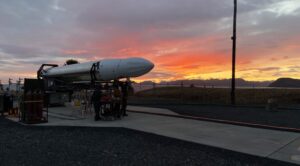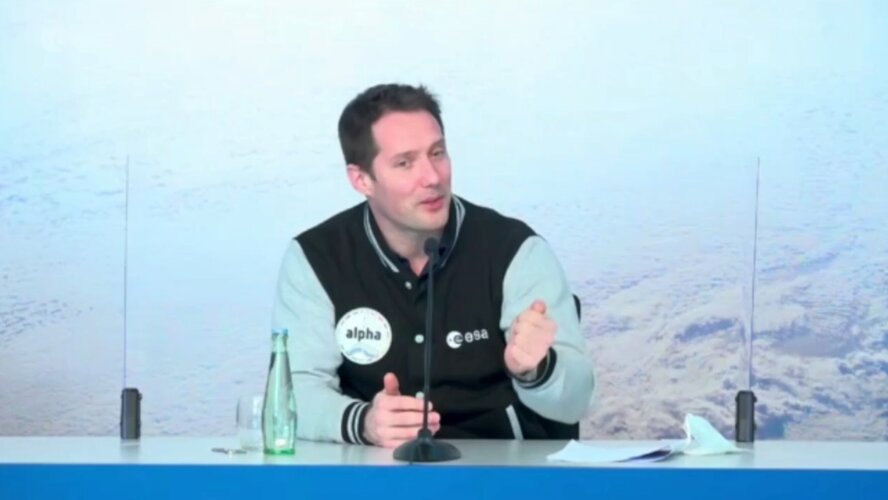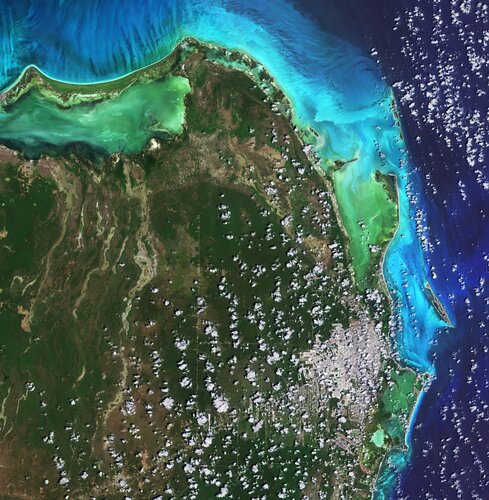Astra says focus is on launch as it files application for satellite constellation
Friday, 12 November 2021 10:32
A week after a filing an application with the FCC for a constellation of more than 13,000 satellites, Astra Space executives said that their near-term focus remains on developing their launch capabilities.
News conference with ESA astronaut Thomas Pesquet
Friday, 12 November 2021 10:00 Video:
00:55:31
Video:
00:55:31
Replay of the news conference with ESA astronaut Thomas Pesquet held at the European Astronaut Centre on 12 November.
Thomas splashed down on Earth after 199 days in space on 8 November. After being helped out of the Crew Dragon Endeavour, just four days later and after a boat, helicopter and multiple aircraft rides, Thomas arrived at the European Astronaut Centre in Cologne, Germany.
A one-hour news conference was held at ESA’s astronaut centre on 12 November.
Programme:
• Welcome by ESA’s Director of Human and Robotic Exploration Dave Parker.
• Statement from ESA’s Director General Josef Aschbacher
• Presentation on ESA’s vision
Earth from Space: Cancún, Mexico
Friday, 12 November 2021 08:00
Cancún, situated in Quintana Roo on the northeast coast of Mexico’s Yucatán Peninsula, is featured in this image captured by the Copernicus Sentinel-2 mission.
The Moon's top layer alone has enough oxygen to sustain 8 billion people for 100,000 years
Friday, 12 November 2021 07:38 Alongside advances in space exploration, we've recently seen much time and money invested into technologies that could allow effective space resource utilisation. And at the forefront of these efforts has been a laser-sharp focus on finding the best way to produce oxygen on the Moon.
In October, the Australian Space Agency and NASA signed a deal to send an Australian-made rover to the Moon
Alongside advances in space exploration, we've recently seen much time and money invested into technologies that could allow effective space resource utilisation. And at the forefront of these efforts has been a laser-sharp focus on finding the best way to produce oxygen on the Moon.
In October, the Australian Space Agency and NASA signed a deal to send an Australian-made rover to the Moon Russia successfully tests 'space radiation shield'
Friday, 12 November 2021 07:38 Space radiation may ride roughshod over a satellite's electrical circuits and result in a full-fledged burnout of its onboard systems. This remains one of the main headaches for satellite manufacturers.
Specialists from the Russian Space Systems holding (RSS) have successfully tested a miniature device designed to protect the electronic onboard systems of state-of-the-art satellites from c
Space radiation may ride roughshod over a satellite's electrical circuits and result in a full-fledged burnout of its onboard systems. This remains one of the main headaches for satellite manufacturers.
Specialists from the Russian Space Systems holding (RSS) have successfully tested a miniature device designed to protect the electronic onboard systems of state-of-the-art satellites from c SpaceX capsule with crew of four docks with ISS
Friday, 12 November 2021 07:38 A SpaceX capsule carrying four astronauts docked with the International Space Station on Thursday, kicking off a six-month stay on the orbiting outpost.
This mission known as Crew-3 is part of NASA's multibillion-dollar partnership with Elon Musk's space company, signed after the Space Shuttle program ended in 2011 and aimed at restoring US capacity to carry out human spaceflight, rather tha
A SpaceX capsule carrying four astronauts docked with the International Space Station on Thursday, kicking off a six-month stay on the orbiting outpost.
This mission known as Crew-3 is part of NASA's multibillion-dollar partnership with Elon Musk's space company, signed after the Space Shuttle program ended in 2011 and aimed at restoring US capacity to carry out human spaceflight, rather tha Matthias Maurer arrives at the International Space Station
Friday, 12 November 2021 07:38 With the launch of 'Cosmic Kiss', Matthias Maurer's long-cherished dream comes true. The Saarland native is the fourth German to travel to the International Space Station (ISS). He departed from Kennedy Space Center in Florida at 21:03 local time on 10 November 2021 (03:03 CET 11 November 2021). The 51-year-old materials scientist from Sankt Wendel has been a member of the European Space Agency
With the launch of 'Cosmic Kiss', Matthias Maurer's long-cherished dream comes true. The Saarland native is the fourth German to travel to the International Space Station (ISS). He departed from Kennedy Space Center in Florida at 21:03 local time on 10 November 2021 (03:03 CET 11 November 2021). The 51-year-old materials scientist from Sankt Wendel has been a member of the European Space Agency Near-earth asteroid might be a lost fragment of the moon
Friday, 12 November 2021 07:38 A near-Earth asteroid named Kamo`oalewa could be a fragment of our moon, according to a new paper published in Nature Communications Earth and Environment by a team of astronomers led by the University of Arizona.
Kamo`oalewa is a quasi-satellite - a subcategory of near-Earth asteroids that orbit the sun but remain relatively close to Earth. Little is known about these objects because they
A near-Earth asteroid named Kamo`oalewa could be a fragment of our moon, according to a new paper published in Nature Communications Earth and Environment by a team of astronomers led by the University of Arizona.
Kamo`oalewa is a quasi-satellite - a subcategory of near-Earth asteroids that orbit the sun but remain relatively close to Earth. Little is known about these objects because they MDA awarded initial design phase contract for lunar rover
Friday, 12 November 2021 07:38 MDA has been awarded a contract by the Canadian Space Agency (CSA) to undertake a Phase A initial design study for a Canadian Lunar Rover mission to the Moon. As part of the CSA's Lunar Exploration Accelerator Program (LEAP), the Lunar Rover will advance eight key technologies that are foundational building blocks for planetary rovers, including mobility, communications, operations, thermal cont
MDA has been awarded a contract by the Canadian Space Agency (CSA) to undertake a Phase A initial design study for a Canadian Lunar Rover mission to the Moon. As part of the CSA's Lunar Exploration Accelerator Program (LEAP), the Lunar Rover will advance eight key technologies that are foundational building blocks for planetary rovers, including mobility, communications, operations, thermal cont Webb's Ariane 5 core stage made ready
Friday, 12 November 2021 07:38 Ariane 5 parts are coming together in the launch vehicle integration building for the launch of Webb from Europe's Spaceport in French Guiana.
The Ariane 5 core stage is 5.4 m diameter and 30.5 m high. On 6 November it was taken out of its shipping container and raised vertical.
At launch it will contain 175 t of liquid oxygen and liquid hydrogen propellants. With its Vulcain 2 engin
Ariane 5 parts are coming together in the launch vehicle integration building for the launch of Webb from Europe's Spaceport in French Guiana.
The Ariane 5 core stage is 5.4 m diameter and 30.5 m high. On 6 November it was taken out of its shipping container and raised vertical.
At launch it will contain 175 t of liquid oxygen and liquid hydrogen propellants. With its Vulcain 2 engin Docking the Perseverance robotic arm
Friday, 12 November 2021 07:38 Every time we collect a rock sample on Mars, Perseverance performs an hours-long set of carefully choreographed operations with its robotic arm, the coring drill, and the Adaptive Caching Assembly. One of these operations is docking: the process by which the arm aligns itself with the Bit Carousel on the front of the rover, so that the corer can drop off and pick up new drill bits.
Docking
Every time we collect a rock sample on Mars, Perseverance performs an hours-long set of carefully choreographed operations with its robotic arm, the coring drill, and the Adaptive Caching Assembly. One of these operations is docking: the process by which the arm aligns itself with the Bit Carousel on the front of the rover, so that the corer can drop off and pick up new drill bits.
Docking China releases information of 15 new lunar samples online
Friday, 12 November 2021 07:38 China has released the information of the third batch of lunar samples brought back by the country's Chang'e-5 mission.
Public users can log on to the website of China's Lunar and Deep Space Exploration (www.clep.org.cn) to check for the related information of the 15 new samples and submit applications for research.
The Chang'e-5 probe returned to Earth on Dec. 17, 2020, retrieving a
China has released the information of the third batch of lunar samples brought back by the country's Chang'e-5 mission.
Public users can log on to the website of China's Lunar and Deep Space Exploration (www.clep.org.cn) to check for the related information of the 15 new samples and submit applications for research.
The Chang'e-5 probe returned to Earth on Dec. 17, 2020, retrieving a Hunting for alien planets
Friday, 12 November 2021 07:38 Thousands of alien worlds are known to orbit stars beyond our solar system. And many more worlds, possibly harboring life, lie waiting to be discovered. A new astronomical instrument called NEID, the NN-explore Exoplanet Investigations with Doppler spectroscopy, has come online in 2021 to help scientists hunt for new alien worlds.
The Texas Advanced Computing Center (TACC) is assisting the
Thousands of alien worlds are known to orbit stars beyond our solar system. And many more worlds, possibly harboring life, lie waiting to be discovered. A new astronomical instrument called NEID, the NN-explore Exoplanet Investigations with Doppler spectroscopy, has come online in 2021 to help scientists hunt for new alien worlds.
The Texas Advanced Computing Center (TACC) is assisting the Circumbinary planet discovered by TESS validates new detection technique
Friday, 12 November 2021 07:38 A new technique developed in part by Planetary Science Institute Senior Scientist Nader Haghighipour has allowed astronomers to quickly detect a transiting circumbinary planet orbiting around two suns, according to a new Astronomical Journal paper on which Haghighipour is an author.
Circumbinary planets are planetary bodies that rotate around two stars. Although for years, they were merely
A new technique developed in part by Planetary Science Institute Senior Scientist Nader Haghighipour has allowed astronomers to quickly detect a transiting circumbinary planet orbiting around two suns, according to a new Astronomical Journal paper on which Haghighipour is an author.
Circumbinary planets are planetary bodies that rotate around two stars. Although for years, they were merely Roman Space Telescope will help drive new era of cosmological discovery
Friday, 12 November 2021 07:38 A team of scientists has forecast the scientific impact of the Nancy Grace Roman Space Telescope's High Latitude Wide Area Survey on critical questions in cosmology. This observation program will consist of both imaging, which reveals the locations, shapes, sizes, and colors of objects like distant galaxies, and spectroscopy, which involves measuring the intensity of light from those objects at
A team of scientists has forecast the scientific impact of the Nancy Grace Roman Space Telescope's High Latitude Wide Area Survey on critical questions in cosmology. This observation program will consist of both imaging, which reveals the locations, shapes, sizes, and colors of objects like distant galaxies, and spectroscopy, which involves measuring the intensity of light from those objects at 
